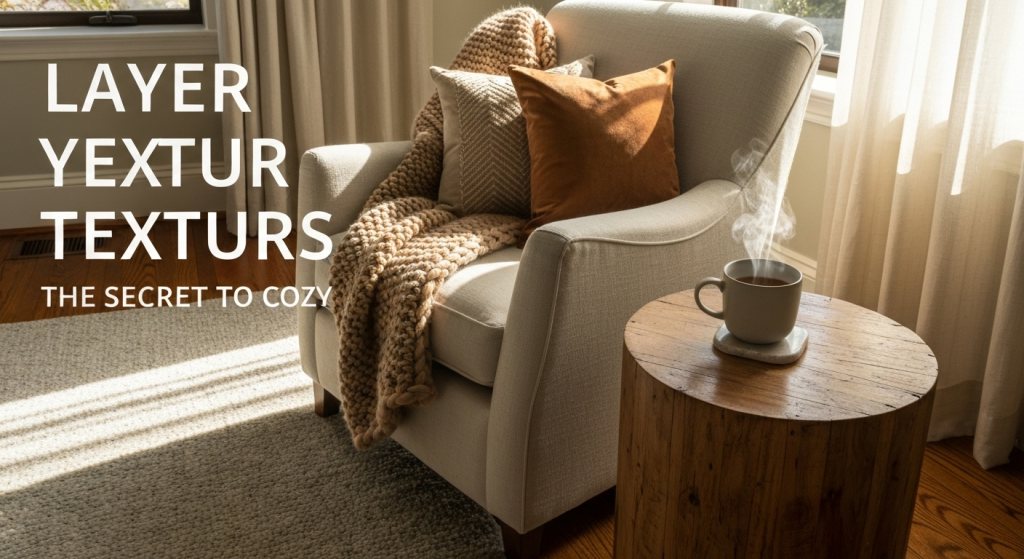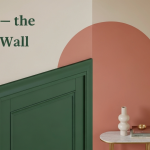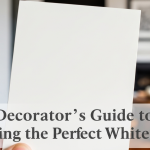Have you ever walked into a room and felt something was… missing? You have a sofa you love, a decent color on the walls, and furniture that serves its purpose. Yet, the space feels flat, maybe even a little cold and impersonal. It lacks that rich, welcoming feeling you see in magazines and professionally designed homes. What you’re likely missing isn’t another piece of furniture or a different paint color. The secret ingredient is texture. Layering textures is the design language that speaks to our sense of touch, transforming a room from a visual concept into an immersive, cozy experience.
My name is William Johnson, and for the past five years, my work has centered on exploring the elements that turn a house into a home. My passion isn’t just about what looks good, but what feels good. I’ve spent countless hours arranging spaces, mixing materials, and learning firsthand how the interplay of a rough-hewn wood against a soft velvet can completely change a room’s energy. This isn’t about following rigid rules, but about understanding materials and sharing what I’ve learned to help you create a space that is genuinely and comfortably yours.
What Exactly Is Texture in Interior Design?
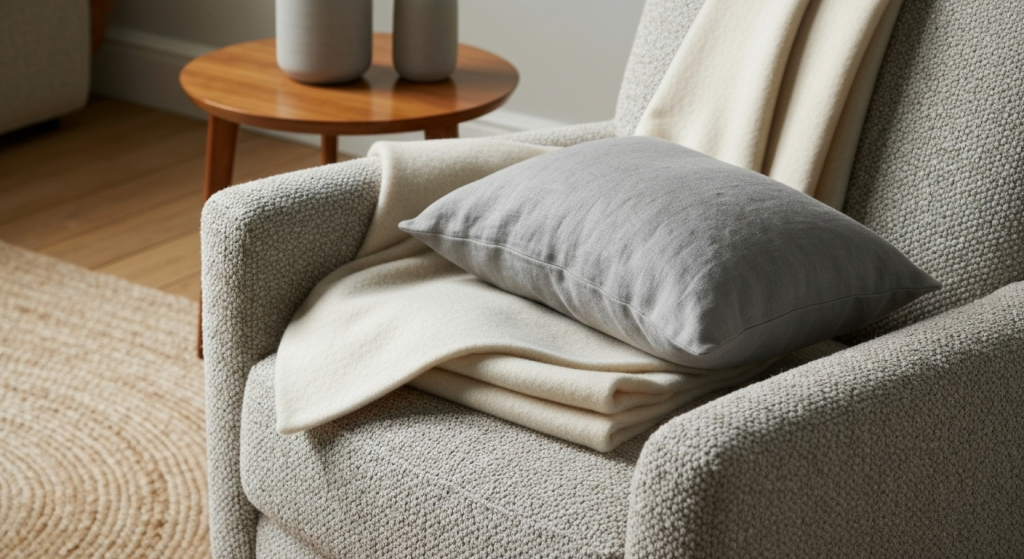
When we talk about texture, we’re discussing the surface quality of an object—how it looks and feels. It’s the difference between the cool smoothness of a marble countertop and the nubby warmth of a wool blanket. In home decor, texture works on two levels:
- Tactile Texture: This is the literal feel of a surface. It’s what you experience when you run your hand over a rustic wooden table, sink your feet into a plush rug, or lean back against a soft linen cushion. It’s the physical sensation.
- Visual Texture: This is the perceived feel of a surface. A pattern on a wallpaper might create the illusion of a rough surface, or the high gloss of a lacquered cabinet suggests smoothness even from across the room. Visual texture adds depth and interest without you ever having to touch it.
Here’s the thing: a room devoid of varied textures relies only on color and shape. This is why a space can feel sterile. By introducing a mix of textures, you create contrast and depth, making the room far more engaging. It gives your eyes different surfaces to land on, creating a subtle sense of richness and complexity. This engagement with our sense of touch is deeply primal; it connects to our feelings of comfort, safety, and warmth.
The Core Principles of Layering Like a Pro
Layering textures isn’t about randomly throwing different materials into a room. It’s a thoughtful process of balancing and contrasting elements to create a harmonious and inviting atmosphere. Let’s break down the foundational principles that I’ve seen work time and time again.
Start with Your Foundation
Before you even think about pillows and throws, look at the biggest surfaces in your room. These are your foundational textures. This includes your walls (are they smooth plaster or textured brick?), your flooring (is it polished concrete, warm hardwood, or soft carpet?), and your largest furniture pieces like a sofa or bed. These elements set the overall textural tone. A room with hardwood floors, a leather sofa, and smooth walls has a sleek, smooth foundation. A room with a carpeted floor and a fabric sofa starts with a much softer base. Understanding your starting point is crucial.
Contrast is Your Best Friend
The magic of layering comes from contrast. You want to create a pleasant tension between different surfaces. This keeps the eye moving and makes each element stand out.
Mixing Hard and Soft Surfaces
This is the most fundamental and impactful way to layer. Hard surfaces like wood, metal, stone, and glass can feel cold on their own. Soft surfaces like wool, linen, velvet, and cotton provide the warmth and comfort. The goal is to balance them.
- On the Floor: Place a soft, high-pile rug on a hard floor like wood or tile. The difference is immediate and dramatic.
- On Furniture: Drape a chunky knit throw over a sleek leather armchair. The juxtaposition of the rugged yarn against the smooth leather is visually stunning.
- On Surfaces: Place a ceramic vase with a matte finish on a glossy side table.
Combining Rough and Smooth Finishes
This principle adds another layer of sophistication. A room where everything is perfectly smooth can feel one-dimensional. Introducing rougher, more organic elements adds character. For example, a live-edge wooden coffee table adds a powerful, rustic touch to a living room with a smooth fabric sofa and polished metal lamps. I once helped a client who felt her all-white kitchen was too clinical. We didn’t change the cabinets or counters; we simply added a rough-hewn wooden bowl for fruit and hung some unglazed earthenware mugs. This small injection of rough texture was enough to give the space warmth and personality.
Playing with Sheen: Matte vs. Glossy
Don’t forget about the way surfaces reflect light. A mix of sheens adds subtle depth. A matte-finish wall can be a beautiful backdrop for a gilded mirror. A polished chrome floor lamp can stand next to a chair upholstered in a flat, matte linen. This interplay between light-absorbing (matte) and light-reflecting (glossy) surfaces makes a space feel more dynamic.
Repetition for a Cohesive Look
While contrast is key, you also need cohesion to prevent the room from feeling chaotic. The trick is to repeat a texture two or three times throughout the space. This repetition ties the room together. For example, if you have rattan chairs in your dining area, you could echo that texture with a rattan basket in the living room and a small rattan-framed mirror in the entryway. The key is not to overdo it. The repetition should feel like a subtle, recurring theme, not a loud, overwhelming pattern.
Your Texture Toolkit: Materials to Know and Use
Building a rich, textured space is like cooking a great meal—you need a variety of quality ingredients. Here’s a look at some of the most common materials you can use to build your texture palette.
A Comparison of Common Decor Textures
| Material | Feel | Vibe | Best Used For |
| Velvet | Soft, plush, dense | Luxurious, glamorous, cozy | Accent chairs, pillows, headboards, curtains |
| Linen | Crisp, airy, slightly coarse | Relaxed, elegant, natural | Curtains, bedding, sofas, pillows |
| Wool | Warm, soft to coarse | Cozy, rustic, comforting | Rugs, blankets, throws, pillows |
| Bouclé | Nubby, loopy, soft | Trendy, comfortable, chic | Chairs, sofas, pillows |
| Jute/Sisal | Rough, fibrous, sturdy | Natural, earthy, coastal | Rugs, baskets, placemats |
| Leather | Smooth, supple | Classic, sophisticated, edgy | Sofas, chairs, ottomans |
| Wood | Varies (smooth to rough) | Warm, grounding, versatile | Furniture, flooring, decorative objects |
| Metal | Cool, smooth | Modern, industrial, sleek | Lighting, table legs, decor, hardware |
Diving Deeper into Soft Textures (Textiles)
Textiles are often the easiest and most affordable way to start layering.
- The Classics: Linen, Cotton, Wool: These are the workhorses of interior design. Linen offers a light, airy feel perfect for curtains and summer bedding. Cotton is versatile and breathable, great for everything. Wool is the king of cozy; a good wool blanket or rug adds unmatched warmth.
- The Luxuries: Velvet, Silk, Cashmere: These fabrics have a higher sheen and a richer feel. Use them more sparingly as accent pieces. A pair of velvet pillows on a simple cotton sofa can elevate the entire look.
- The Naturals: Jute, Sisal, Rattan: These bring the outdoors in. Their raw, fibrous texture provides a wonderful contrast to smoother surfaces. A jute rug is fantastic for grounding a living room.
- The Trendsetters: Bouclé, Sherpa: These highly tactile fabrics have surged in popularity for a reason. Their looped and fuzzy surfaces are incredibly inviting and add a touch of modern comfort to armchairs and pillows.
Understanding Hard Textures (Surfaces)
Hard surfaces provide the essential structure and contrast for your soft layers.
- Wood: The finish matters immensely. A piece of smooth, polished walnut feels very different from a piece of rough, reclaimed pine. Use this variation to your advantage.
- Metal: Don’t just think of chrome. Matte black metal offers an industrial edge, while brushed brass or gold adds warmth and glamour. Mix metals for a curated, modern feel.
- Stone & Ceramic: From the polished elegance of marble to the earthy feel of terracotta, these materials add a grounding, solid presence. Even small items like a ceramic lamp base or a stone coaster contribute to the textural story.
- Glass & Mirror: These elements are textural chameleons. They are physically smooth but visually add immense depth by reflecting light and the other textures in the room.
A Practical Guide: Layering Textures Room by Room
Let’s apply these principles to the most common spaces in a home.
The Living Room: The Social Hub
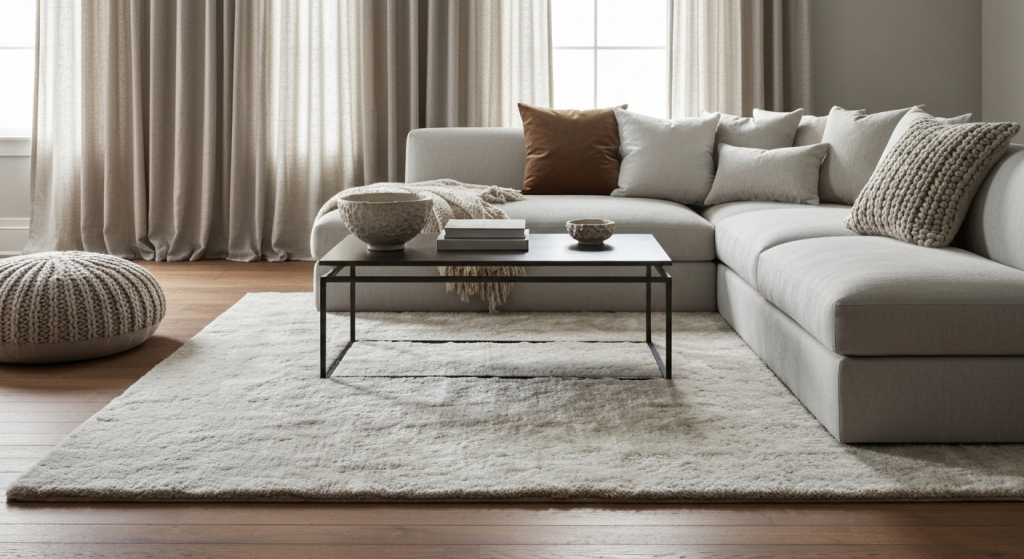
The living room is the perfect place to experiment with bold texture combinations.
- Start with the Rug: This is your anchor. A large jute rug can define the space with natural texture. If you want more comfort, try a plush wool rug or even layer a smaller, softer rug on top of the jute one.
- The Sofa and Chairs: This is your main soft surface. On the sofa, add pillows of varying materials. A common formula I use is: two 20-inch pillows in a base fabric like linen, two 18-inch pillows in a richer fabric like velvet, and one lumbar pillow with a unique texture, like embroidery or a chunky knit.
- Mix Your Tables: If you have a wooden coffee table, consider metal or glass side tables. The contrast between materials will make each piece more interesting.
- Add the Final Layers: Drape a soft throw over the arm of the sofa or a chair. Bring in plants with different leaf shapes (visual texture!). Finally, consider your window treatments. Flowy linen curtains add a soft, diffused light, while heavier velvet curtains add drama and warmth.
The Bedroom: Your Personal Sanctuary
In the bedroom, the goal is ultimate comfort and tranquility. Textures should be soothing and inviting.
- Bedding is Everything: This is where you can truly indulge in layering. Start with crisp cotton or soft percale sheets. Add a linen or cotton duvet. Fold a waffle-weave or chunky knit blanket at the foot of the bed. Finally, prop up a mix of sleeping pillows and decorative shams—perhaps a pair of smooth silk pillowcases for a touch of luxury.
- The Headboard: An upholstered headboard in linen, velvet, or bouclé immediately softens the room. If you have a wooden or metal bed frame, you can soften it with an array of plush pillows.
- Soften the Floor: A soft rug on either side of the bed is a must. Waking up and stepping onto a warm, plush surface instead of a cold, hard floor is a small daily luxury that makes a huge difference.
- Seating and Lighting: If you have space, a small armchair in a tactile fabric like sherpa or bouclé creates a cozy reading nook. A lamp with a linen shade will cast a softer glow than one with a metal or glass shade.
Common Texture Mistakes and How to Fix Them
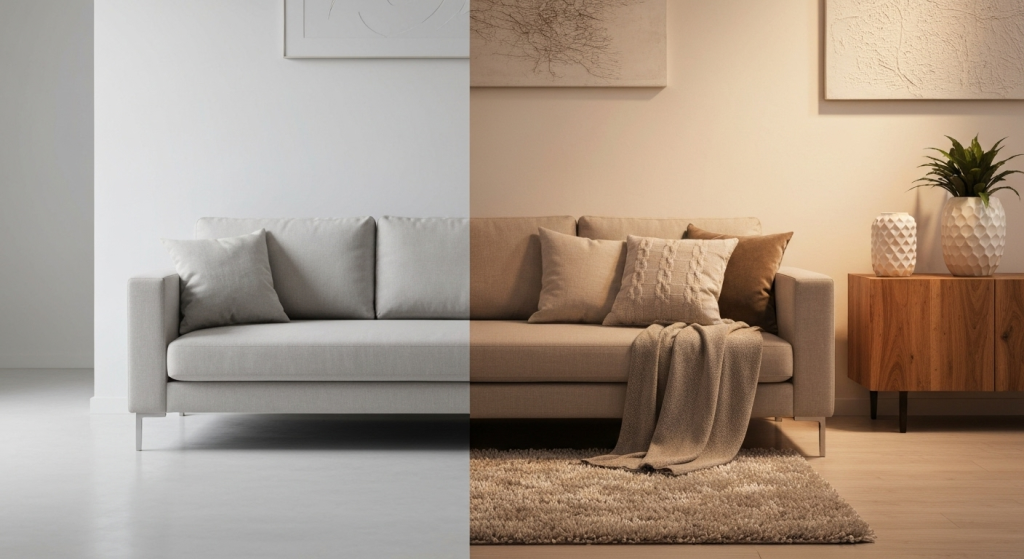
As you start your layering journey, it’s easy to fall into a few common traps. The good news is that they are all easily fixable.
- The “One of Everything” Problem: In an effort to add texture, you might be tempted to include every material you like. This leads to a space that feels cluttered and lacks direction.
- The Fix: Stick to a palette of 3-5 dominant textures per room. This allows each texture to shine without creating chaos.
- Playing It Too Safe: This is the opposite problem—a room where everything is cotton, light wood, and not much else. It’s not offensive, but it’s not inspiring, either.
- The Fix: Be bold with one or two choices. Swap your plain cotton pillows for rich velvet ones. Add a single faux fur throw. Introduce one “wow” piece, like a rough-hewn wooden bench.
- Forgetting Scale: Scale applies to texture just as it does to furniture size. A tiny, delicate pattern can get lost in a large room, while a very bold, rough texture can overwhelm a small space.
- The Fix: In a large room with high ceilings, use larger-scale textures like chunky knits, wide-plank wood floors, and large-weave rugs. In a smaller room, stick to finer textures like linen, smooth velvets, and tightly woven rugs.
Here is a quick troubleshooting guide:
| If Your Room Feels… | Try Adding… |
| Cold or Echoey | Soft, sound-absorbing textures: plush rugs, heavy curtains, upholstered furniture, and lots of pillows. |
| Boring or Flat | High-contrast textures: a rough jute rug under a smooth coffee table, or a shiny metal lamp on a matte wood console. |
| Cluttered or Chaotic | Cohesion through repetition. Remove a few competing textures and repeat your favorite one (like linen or brass) in 2-3 spots. |
| Too “New” or Sterile | Natural, aged textures: reclaimed wood, aged leather, unglazed pottery, or vintage textiles. |
Frequently Asked Questions
How many textures are too many in one room?
A good rule of thumb is to work with a primary palette of 3 to 5 distinct textures. For example, in a living room, this could be linen (curtains, pillows), wool (rug), wood (coffee table), metal (lamp), and velvet (accent chair). This provides variety without feeling overwhelming.
Can I mix warm textures (like wool) with cool textures (like metal)?
Absolutely! In fact, you should. The contrast between warm textures (wood, wool, chunky knits) and cool textures (metal, glass, stone) is what creates a balanced and interesting space. A warm wool throw on a cool metal chair is a perfect example of this principle in action.
What’s the best way to start layering textures if I’m a beginner?
Start small and affordably with textiles. Buy a few new pillow covers in different materials like velvet, linen, or a knit fabric. Add a new throw blanket to your sofa or bed. These small changes can have a huge impact and will help you build confidence.
Do patterns count as texture?
Yes, in a way. Patterns primarily create visual texture. A floral wallpaper or a geometric rug adds depth and complexity to a room’s look. The key is to balance busy patterns with solid-colored, tactile surfaces to avoid making the space feel too busy.
Conclusion: Trust Your Senses
Creating a textured, inviting home isn’t about buying a whole new set of furniture. It’s about being more intentional with the surfaces you choose to surround yourself with. It’s about paying attention not just to how your home looks, but how it feels to live in. The most beautifully designed spaces are those that engage all our senses, inviting us to touch, to relax, and to feel truly comfortable.
So, start exploring. Visit a fabric store and feel the difference between bouclé and velvet. Notice the grain on a piece of wood. Pick up a ceramic mug and appreciate its earthy texture. Begin by adding one new element—a single plush pillow or a soft new throw—and see how it changes the feeling of your space. Trust your instincts, have fun with it, and you’ll soon craft a home that is as rich and layered as you are.
